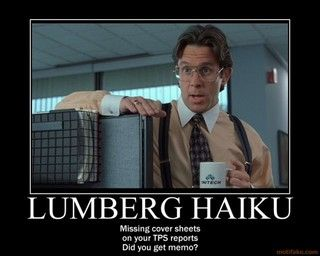How to tell if your work environment is toxic (as told by Office Space)
So I was thinking of all the different ways I could write this blog, and most of them were pretty depressing. I’ve worked in toxic work environments before, or more aptly I should say I survived those jobs. Now that I’m doing something I love in a company that values my contributions, it’s no fun to relive some of those moments. Which is probably why I thought of Office Space so much while I was planning this out. Also, I wanted to bring a bit of levity to a serious subject.
If you haven’t seen it (and, if not, why, WHY?), the following memes might not be quite as funny, but I think you’ll get the gist.
So here, as told by Office Space memes, are telltale signs of a toxic work environment, and some suggestions to get you or your team on a better path.
Work hours are more important than productivity
Let’s start off with a broad-reaching category and talk about overtime. My first job in Japan was for a Japanese company—the hours were very long and you were expected to continue working until your boss checked out for the day. Which often meant hours of unproductive work in the evenings. This extreme might be uniquely Japanese. But have you ever worked for a company that put an absurd emphasis on hours worked versus productivity?
Have you ever thought that to get ahead you’d have to be visibly working so that the image others would have of you is as a hard worker?
Does unappealing work tend to, like certain other things, roll downhill?
In a remote context, are you worried that signing off or that using “Do Not Disturb” in Slack or other tools might lead to uncomfortable questions?
SOLUTION
For employees, make sure that work goals are written down and agreed regularly. This can happen in a quarterly review or at regular 1-on-1s. If you aren’t having these already, start insisting on them or things will get worse.
For leaders, make sure decisions related to time management and priorities are rational and well thought out. If you’ve recently moved to a remote or hybrid setup, train your managers or other leaders on creating psychologically safe environments.
You work on things no one seems to care about or need
Have you ever completed a project, only for it to disappear into the void, totally unused and unappreciated?
Do you sometimes feel it doesn’t really matter what you are working on, and that no one really notices anyway?
Obviously companies don’t set out to create useless processes and reports, but as they get larger it’s common for certain things to stick, even if they are no longer needed. This creates a lot of busywork and a culture that doesn’t reward productivity or efficiency, which quickly leads organizations away from meritocracy and towards a toxic environment.
SOLUTION
If the person checking off unimportant boxes all day is seen as the most productive, innovation will die. For employees, ask for feedback on your work from your manager or other people involved in the project. If something really isn’t being used, you’ll have a way to push back on its importance in the future.
A good rule of thumb for leaders is: if you add something, subtract something as well. A question I like to ask during 1-on-1s is “If you are doing this, what are you NOT doing?” It’s a way to check priorities and ensure what people are working on is actually a priority and not busywork or a distraction.
You often have “A case of the Mondays”
You’re not going to be 100% motivated every day. You could be [insert your ideal job] and there will be days where nothing clicks. Maybe it’s the weather. Maybe you’re working on a project that just isn’t very interesting for you. That’s normal. There are parts of every job that are unexciting and mundane, but they have to be done.
But if you’re feeling that way often, then that’s a bad sign.
Only recently has the idea of Mental Health Days been accepted, and even then, probably only the most progressive businesses have policies written down. If that’s even an option for you, your company is at least making an effort.
In a toxic work environment, however, you might be ostracized for using those days or have no choice other than taking a sick day.
SOLUTION
At this point, you should be asking yourself “Is it me or the company that’s the problem here?” If the answer is “it’s me” you should evaluate what you’re doing and what you’re learning and decide if those things are motivating for you. This issue often comes down to a lack of progress.
For leaders, the answer is somewhat similar, as stagnation among the workforce often has similar warning signs. As above, regular check-ins during 1-on-1s or reviews can help unlock these issues—with the big caveat that people are willing to tell you the truth. If not, you need to get back to basics and work on Psychological Safety.
The goalposts are constantly moving
Do you know exactly what’s expected of you? Do you have clear targets and goals?
If not, the environment might not be toxic yet, but it’s heading in that direction. Without clear goals, you will likely feel adrift—and if others in your team or company feel the same that means people are out of alignment with the overall mission. This is potentially an early warning sign of mission drift, and it’s likely to get worse.
SOLUTION
Moving goalposts leaves people unsettled and unsure of what they should be doing. Without clear expectations, people are unable to deliver their best work. This is about finding the right balance between security and autonomy.
If you are in this situation, ask for clear and defined goals and promotion targets. Ask if any changes within the company or team could impact your goals. Get clarity, and if it can’t be provided, start thinking about your options.
The flipside is that leaders need to be prepared to have this conversation when asked, but shouldn’t wait to be asked if it can be helped. Avoiding the conversation means you’re actually avoiding a much bigger problem, either culturally within the company or with that specific person.
“We don’t have a lot of time on this Earth! We weren’t meant to spend it this way!"
Office Space nailed it—there’s a reason it’s a cult classic. Most people spend at least eight hours a day, five days a week working. Will you love every day? No. Some days will suck and be a slog to get through. But those days should be the exception rather than the rule. If your motivation is at zero and you feel that what you are doing doesn’t matter, it’s important to evaluate yourself and the environment around you and commit to changes.
For leaders, don’t be Lumberg. Don’t be Stan either (Jennifer Aniston’s flair-obsessed supervisor). While they arguably had good intentions (Stan anyway, I’m not sure Lumberg even had a soul), by mindlessly pushing the status quo they were reinforcing a toxic work culture.
As a leader, it’s your responsibility to motivate your team and create an environment where happiness and productivity go hand-in-hand.
Download The State of Motivation Report 2025. It’s free!






